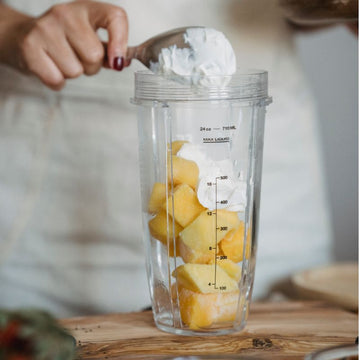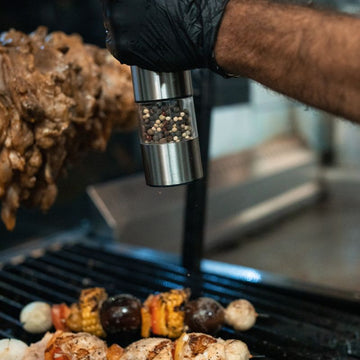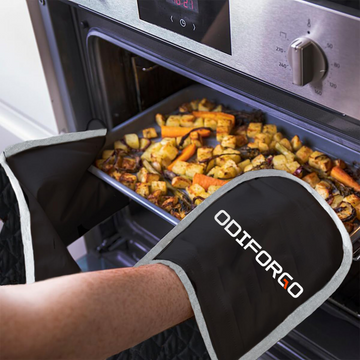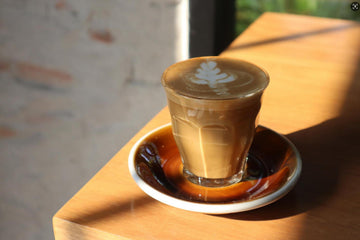Choosing between a cortado vs latte comes down to balance, texture, and size. Both are espresso-and-milk classics, but they deliver very different experiences. A cortado pairs equal parts espresso and lightly steamed milk for a small, bold, and smooth sip with minimal foam. A latte uses more milk and silky microfoam for a creamier, larger drink with a gentler coffee flavor.
In this guide, we’ll break down what each drink is, how to make them at home, key differences in milk ratio, texture, flavor, size, calories, and caffeine, plus quick tips to pick the right one for your taste and routine.
What is cortado
A cortado is a compact espresso-and-milk drink with Spanish roots, designed to “cut” espresso’s intensity with just enough warm milk. It’s typically a 1:1 ratio of espresso to milk, yielding about 3–4 oz total volume. The milk is steamed for warmth and silkiness, not foam, so the drink stays smooth and espresso-forward rather than airy or creamy.
Expect a rounded acidity, fuller body, and lingering chocolatey or nutty notes if using medium to medium-dark roasts. It’s commonly served in a small glass (like a Gibraltar or a 4 oz rocks glass), often without latte art because the foam layer is so thin. Compared to other small espresso drinks, a cortado has more milk than a macchiato and less texture and volume than a flat white.
How to make cortado
-
Pull a double shot: Use 18–20 g of coffee for about 36–40 g espresso in 25–30 seconds. Aim for a balanced extraction with syrupy body.
-
Steam the milk: Heat to 140–150°F (60–65°C). Introduce minimal air for a thin, glossy texture with nearly zero foam.
-
Pour 1:1: Combine roughly 2 oz espresso with 2 oz milk. Pour steadily to integrate without building a thick head.
-
Serve immediately: Use a 3–4 oz glass to preserve temperature and balance.
Extra tips
-
Beans: Medium or medium-dark roasts highlight sweetness and body; lighter roasts will taste brighter and more citrusy.
-
Milk choices: Whole milk gives the smoothest mouthfeel. Oat and barista-style alternative milks work well; keep aeration minimal to avoid a fluffy cap.
-
Temperature control: Stop steaming a few degrees early—milk continues to rise slightly after you turn off the steam.
-
Home method without steamer: Heat milk gently on the stove or microwave to sipping warm (not hot), then whisk briefly for a fine texture without foam.
-
Espresso tuning: If the cortado tastes sharp, grind slightly finer or increase yield a touch. If it’s dull, coarsen slightly or shorten the shot.
What is latte

A latte is a creamy, milk-forward espresso drink that originated in Italy and became a café staple worldwide. Built on one or two shots of espresso topped with a generous amount of steamed milk and a thin layer of microfoam, it’s smoother and sweeter than smaller espresso drinks. Typical ratios range from 1:3 to 1:5 espresso-to-milk, yielding 8–12 oz in most cafés (sometimes up to 16 oz in the U.S.).
The hallmark of a latte is silky, velvety milk with about 0.5–1 cm of fine foam—perfect for latte art. Flavor-wise, expect mellow acidity, caramel-like sweetness from steamed milk, and a plush texture that softens espresso’s bite. Lattes also take well to flavored syrups and alternative milks, making them a versatile choice for beginners and coffee enthusiasts alike.
How to make latte
-
Pull your espresso: Use a double shot (about 18–20 g in, 36–40 g out) in 25–30 seconds. Aim for a balanced, slightly sweet shot.
-
Steam the milk: Heat to 150–155°F (65–68°C). Introduce a bit more air than for a cortado to create silky microfoam—fine bubbles, glossy sheen.
-
Target volume: For a classic 10–12 oz latte, you’ll need roughly 6–8 oz of cold milk before steaming, depending on pitcher size and foam.
-
Pour and integrate: Swirl the pitcher to polish the texture, tap out big bubbles, then pour steadily. Start higher to mix, lower the spout to finish with a thin foam cap or latte art.
-
Serve immediately in a preheated 10–12 oz cup.
Extra tips
-
Milk choice: Whole milk delivers the creamiest texture and best art. Barista-formulated oat and almond milks can produce stable microfoam—adjust aeration slightly higher for non-dairy.
-
Temperature control: Milk sweetness peaks around 140–155°F (60–68°C). Above 160°F (71°C) it loses sweetness and can taste “cooked.”
-
Foam thickness: Aim for a thin, paint-like microfoam layer—not a cappuccino’s dry, thick foam. If the texture is bubbly, you added too much air or didn’t whirlpool enough.
-
Shot tuning: If your latte tastes flat, shorten the shot or grind finer. If it’s harsh, coarsen slightly or extend the yield for more clarity.
-
Flavor add-ins: Dissolve syrups in the hot espresso before adding milk for even sweetness. Spices like cinnamon or cocoa dust best after pouring.
-
No steam wand? Heat milk gently to sipping warm, then use a French press or handheld frother to create fine microfoam. Swirl to polish before pouring.
-
Iced latte variation: Pull a double shot over ice, add cold milk to 12–16 oz, and skip steaming. Use slightly stronger espresso or a ristretto to stand up to dilution.
Cortado vs. Latte
|
Attribute |
Cortado |
Latte |
|
Origin |
Spain |
Italy |
|
Typical size |
3–4 oz |
8–12 oz (up to 16 oz) |
|
Espresso-to-milk |
~1:1 |
~1:3 to 1:5 |
|
Milk texture |
warm, silky, minimal foam |
velvety microfoam, thin cap |
|
Flavor profile |
espresso-forward, rounded acidity |
milk-forward, mellow and sweet |
|
Temperature |
warm, not hot |
hotter, but below 160°F/71°C |
|
Mouthfeel |
compact, dense |
creamy, plush |
|
Vessel |
small glass (Gibraltar/rocks) |
ceramic cup (10–12 oz) |
|
Latte art |
uncommon/minimal |
common, ideal canvas |
|
Customization |
usually plain |
frequently flavored/syrup-friendly |
|
Best for |
bold espresso lovers |
smooth, easy-drinking comfort |
|
Iced version |
rare, short build |
common, larger and milkier |
Final thoughts
Whether you lean cortado or latte, you’re choosing between two excellent espresso drinks that simply highlight different strengths. If you crave an espresso-forward cup with just enough silkiness to soften the edges, the cortado is your compact, no-frills winner. If you want a longer, creamier sip with room for latte art and flavor tweaks, the latte is your reliable everyday comfort.
The best part is how easy it is to dial each in at home. Start with fresh beans, pull a balanced double shot, and adjust milk texture to match the drink: minimal foam for a cortado, silky microfoam for a latte. Not sure which is “you”? Order both on your next café visit, or brew them back-to-back and taste the contrast while they’re fresh.
Whichever you choose, focus on temperature, texture, and balance—small tweaks make a big difference. And if you’re exploring more espresso drinks, use this latte vs cortado primer as your compass for dialing in taste, texture, and size to match your mood.
FAQs
Do lattes or cortados have more caffeine?
Caffeine depends on the number of espresso shots, not the milk. Many cafés use a double shot in both. If a latte is made with two shots and a cortado with one, the latte will have more caffeine—otherwise, they’re the same. Roast level impacts flavor more than caffeine; dose and yield matter most.
What non-dairy milk foams closest to dairy for latte art?
-
Barista-formulated oat is the closest all-rounder, offering glossy microfoam and good pour control.
-
Soy can work well but is sensitive to high heat and acidity—steam slightly cooler.
-
Pea-protein blends produce stable foam and neutral flavor.
-
Almond is lighter and can split; add a touch more air and keep temps lower.
-
Aim for 140–150°F (60–65°C) and slightly more aeration than dairy.
Which beans and roast levels pair best with each drink?
-
Cortado: medium or medium-light roasts, single origins with citrus, berry, or floral notes, pulled as a normale shot for clarity and structure.
-
Latte: medium to medium-dark blends with chocolate, caramel, and nut notes, often as a slightly shorter shot (ristretto to normale) to punch through milk.
-
For both: prioritize freshness (7–30 days off roast), consistent grind, and a 1:2-ish brew ratio as a starting point, then adjust to taste.














